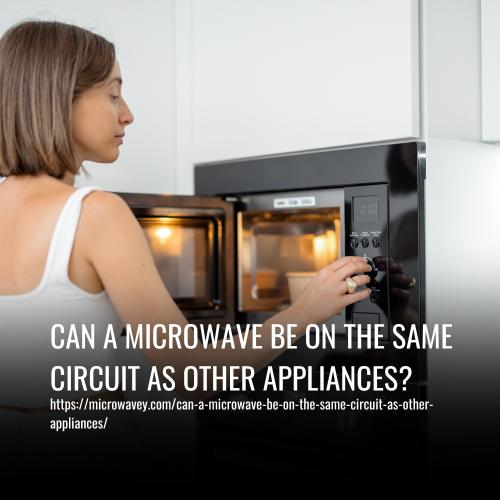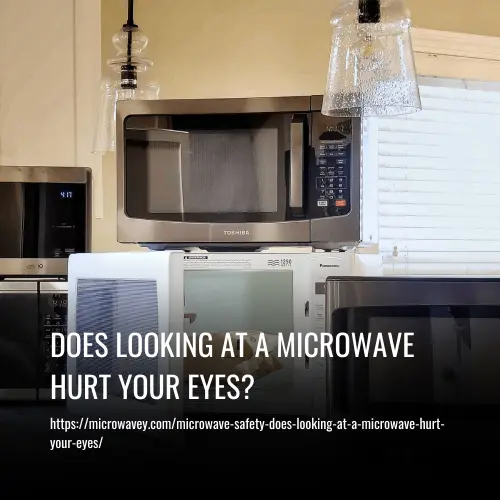Can A Microwave Be On The Same Circuit As Other Appliances?
A microwave should typically be on a separate circuit from the rest of a kitchen’s appliances. If one’s appliances have unusually small power requirements, one might be able to place them on the same circuit, but otherwise, it can cause fires or trip the circuit breaker.
The specifics about why you probably shouldn’t use a microwave on the same circuit as other appliances will be explained in the rest of this article. Read on to find out if and why you shouldn’t.

Why Can’t a Microwave (Usually) Be on the Same Circuit as Other Appliances?
The reason a microwave can’t be on the same circuit as other appliances is relatively simple: appliances draw large amounts of power, and a typical home electrical circuit only has so much power to offer. In a home that receives the typical 120 volts of electricity, a 15 amp circuit (which is also typical; some homes have 20 amp circuits though) can safely allow for the use of 1800 watts of power. When the same circuit has an appliance that is run continuously for over 3 hours (such as a refrigerator), this safe limit is reduced by 20%, to 1440 watts.
Now, a 20-amp 120-volt circuit can handle around 2,400 watts, or 1,920 watts if there is an always-on appliance connected. This does give you some leeway compared to a 15-amp circuit, although that power can get pulled pretty fast if you’ve got power-hungry appliances like a microwave connected. Most kitchens built more recently, say within the past 20 years or so, have 120-volt outlets, which gives you a lot more power. You could probably get away with an efficient microwave and refrigerator plugged into the same outlet. Most of the time though, you’re still going to want to get separate outlets/circuits for each appliance.
Energy Demands of Common Kitchen Appliances (in Watts):
- Dishwasher: 1,200-1,500.
- Coffee Machine: 1,000.
- Blender: 500.
- Electric Kettle: 1,200.
- Refrigerator Average Watts: 300-800 W.
- Garbage Disposal: 450.
- Oven-Electric: 1200.
- Toaster: 850.
- Microwave: 1,000.
As you can see, the needs of just one fridge can require all of the power from a single circuit. It is for this reason that most people give the fridge itself its circuit. This also helps to prevent the fridge from letting your food go bad during a brownout, in which less than the optimal 120 volts is reaching your home from the power company.
And of course, all of these power needs can vary widely. A typical microwave oven can use anywhere from 600 to 1,500 watts, depending on its cooking power, size, age, and more. And of course, there are dozens of different appliances that a typical person might be using in their kitchen at any given time, including mixers, blenders, pressure cookers, toaster ovens, electric griddles, waffle-makers, and more. Any of these can take more or less power than average.
Ways to Get Around Using a Separate Circuit
Now, while it is certainly not recommended (and can be unsafe if the breaker fails to trip before a fire starts instead), there are ways to avoid using a separate circuit for your microwave and other appliances. Some of these methods include:
- Unplug your fridge from the wall when you use your microwave. Be careful to remember to plug your fridge back in afterward, as you don’t want your food to go bad! Now, using a fridge in combination with your microwave is particularly unrecommended, because if your fridge can’t pull enough power, your food will start to spoil early. And of course, if your fridge decides to turn on (your fridge turns on periodically throughout the day to maintain temperature) right at the same time as you’re using the defrost feature on your microwave, it may cause a short.
- If your microwave is on a shared circuit, just don’t use multiple appliances at the same time. Now, if you calculate that your minor appliances won’t draw enough power to be a problem, then you can use them at will, but most of the time you probably won’t want to bother to do so. And of course, a minor short once-in-a-blue moon is usually not the end of the world.
- Some small countertop microwaves don’t draw that much power. If your microwave is particularly energy-saver friendly, then perhaps you can get away with using it in conjunction with other appliances on the same circuit.
Can You Use a Microwave on a Power Strip?
Using a microwave on a power strip/surge protector is generally a bad idea. Even when a power strip is supposedly rated for 15 amps, the fact is that something as power-hungry as a microwave will draw right up to the limit of what the power strip can give. If a microwave overloads a power strip, then it can cause the plastic of the strip to melt or even an electrical fire! You should always plug a microwave into a grounded outlet that has the proper amperage.
Now, if you do happen to have a high-quality power strip/surge protector that is rated for the kind of power draw a microwave has, just make sure not to plug other appliances into it. The same voltage limits discussed earlier still apply to a surge protector, and you don’t want to overload it.
However, the fact of the matter is that even if your power strip says it is powerful enough, it still is a lot less safe than using a wall outlet. Insurance companies probably will be a lot more resistant to paying for damages caused by an electrical fire if it originated as a result of you using a microwave or other large appliance that is plugged into a power strip.
Can You Put Your Microwave on Top of the Fridge?
While it is still important to make sure your fridge and your microwave are on separate circuits, most of the time, it is ok to put your microwave on top of the fridge.
However, some considerations are good to keep in mind:
- A mini fridge still uses a decent amount of power, so it is still not recommended to plug both a mini-fridge and a microwave into an outlet, although if they are both relatively power-efficient you may be fine.
- Most microwaves vent heat out of the top and back, meaning that most of the heat will still vent away properly if the microwave is on top of the refrigerator. However, if the microwave was designed to be used in an enclosure originally, then it may be possible that it vents heat downward as well as upward and backward. This can cause damage to the top of your fridge if it is the case.
- There is still residual heat produced by a microwave, that can interfere with your fridge’s ability to vent hot air properly. This extra heat may cause your refrigerator’s condenser to turn on more often, meaning a higher electricity bill. This can cause unnecessary wear and tear on your fridge.
- Make sure that the top of the fridge is flat, and that it has enough space for your microwave. You don’t want your microwave to fall as a result of faulty footing!
Managing One Kitchen Outlet For Fridge And Microwave.
It is possible to have two circuits connected to the same outlet, as long as those two circuits don’t overload the outlet rating. Most outlets, however, draw power from the same circuit, and thus the two plug-ins share the same circuit. This is bad news if you are trying to use large appliances such as a microwave and fridge on that outlet simultaneously.
However, it is possible, with the right know-how or with the help of an electrician, to separate the connection between the top and bottom half of an outlet, and then use some additional wiring to create another circuit. This can be somewhat complicated, so don’t hesitate to get an electrician to come to do it, as they are required to make sure that their work is up to code, and they don’t want to be held liable in the case that the wiring is faulty and causes excessive shorts or a fire.
International Considerations
Different countries have different standard setups for their electrical grid. Some countries typically have different voltages running to residential properties than our standard 120-volt setup. The amperage of an up-to-code circuit can also differ.
If you are trying to use an appliance like a microwave that was made in or made for America, then you may have to check to see if the outlets where you are traveling or moving to are compatible, not to mention that you may need a converter to use it at all in the first place. If your appliance draws more power than an outlet can provide, it can cause all sorts of problems with the appliance itself, not to mention that it will trip the breaker.
FAQs
Yes, a microwave can be on the same circuit as other appliances, but it’s important to consider the electrical load. Microwaves typically draw a significant amount of power, so if other high-power appliances are also on the same circuit, it may overload the circuit and trip the breaker.
If a microwave shares a circuit with other high-power appliances such as a refrigerator or air conditioner, there’s a risk of overloading the circuit. This can lead to the breaker tripping frequently, potentially causing inconvenience and electrical hazards.
To determine if your microwave shares a circuit with other appliances, check the circuit breaker panel in your home. Look for the circuit breaker labeled for the kitchen or designated for the microwave outlet. If other major appliances are also connected to the same breaker, they share the same circuit.
It can be safe to have a microwave on the same circuit as other appliances as long as the total electrical load does not exceed the circuit’s capacity. However, it’s recommended to have dedicated circuits for high-power appliances like microwaves to prevent overloading and ensure reliable operation.
To avoid overloading a circuit with a microwave and other appliances, consider installing dedicated circuits for high-power appliances. This ensures that each appliance has its own circuit and reduces the risk of overloading. Additionally, avoid using multiple high-power appliances simultaneously on the same circuit.
If the circuit breaker trips frequently when using the microwave with other appliances, it indicates that the circuit is overloaded. To resolve this issue, redistribute the appliances to different circuits or consider installing additional circuits to accommodate the electrical load. It’s essential to consult a qualified electrician for proper circuit installation and safety precautions.
Conclusion
While a microwave can be on the same circuit as other appliances, it is important to assess the electrical load and ensure that the circuit can handle the combined power usage. Safety should always be the top priority when it comes to electrical connections in your home.
So, before making any decisions, consult with a professional to ensure that your appliances are properly and safely connected.

